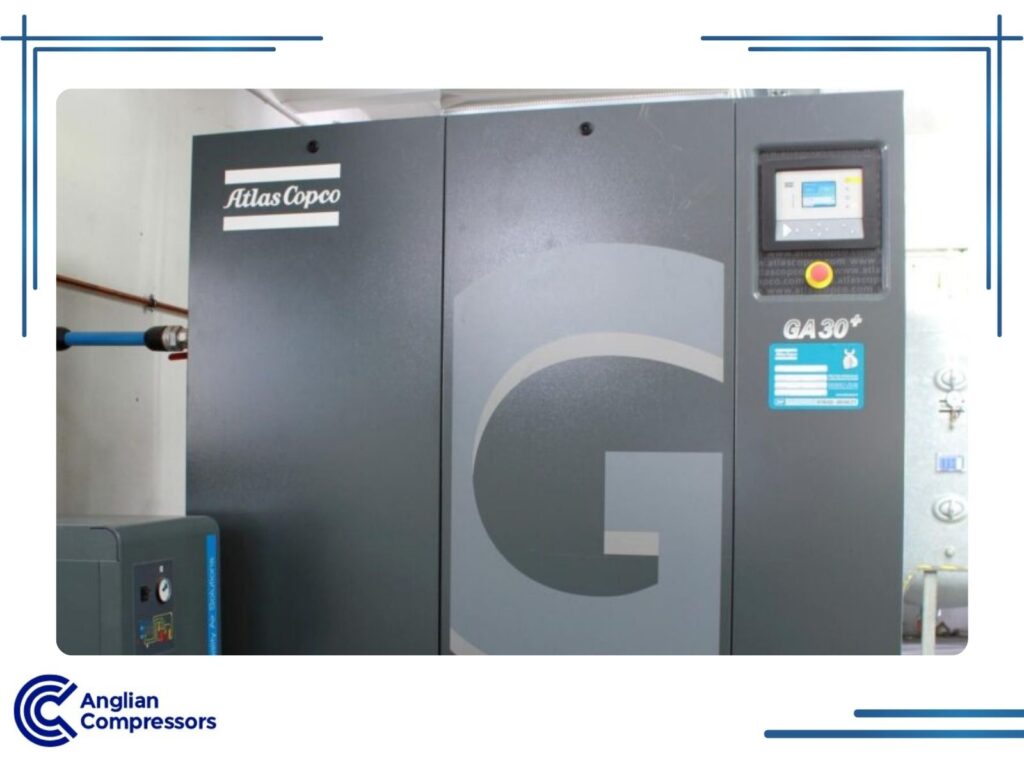Energy Recovery for Air Compressors
Compressed air systems are major energy consumers, making them an ideal focus for energy-saving efforts. By harnessing the excess heat generated by these systems through heat recovery, businesses can tap into a valuable source of energy conservation.
In this article, we’ll look at all the potential energy savings, seasonal factors, and how modern air compressors incorporate heat recovery in their design.
By the end, you’ll have a better understanding of how heat recovery can help you reduce energy costs, lower CO2 emissions, and improve the sustainability of your operation.
Table of Contents
Understanding Energy Recovery for Air Compressors
Compressed air systems generate a significant amount of heat as a byproduct of their operation. This is simply due to the physics of compressing large volumes of air, which is common in industries that rely on air-powered tools and equipment.
While the energy used to compress the air can’t be directly recovered, the excess heat generated can be harnessed. This is the core idea behind energy recovery or heat recovery systems for air compressors. By capturing and repurposing this otherwise wasted heat, businesses can reduce their overall energy consumption and lower CO2 emissions.
How Heat and Air Compressors Are Intertwined
Why is heat generated at all?
Because compressed air systems use nearby or outside air as an input, then compress it into a smaller space. This activity produces compression heat, a by-product of the process. However, compressed air must be cooled, so the heat is extracted from the system before the compressed air is made available. The extracted heat is then considered ‘waste heat’.
Excess heat is often expelled outside the rear of the factory. Hot air from an oil-free compressor is devoid of oil particulates, so does not pose a risk to the environment. A cooling water system is sometimes used to reduce the total heat level for safety purposes. However, these approaches won’t directly or indirectly save energy.
Benefits of Energy Recovery
Energy recovery offers a multitude of benefits that go beyond simply reducing your energy bills. It’s a smart investment that positively impacts your bottom line, the environment, and the longevity of your equipment.
Significant Cost Savings: By harnessing the waste heat generated by your air compressor, you can significantly reduce your reliance on traditional heating and cooling systems. This translates to lower energy consumption and substantial cost savings over time.
Environmental Responsibility: As a business owner, you have a responsibility to minimise your environmental impact. Energy recovery is a powerful tool in this effort. By utilising waste heat, you’ll decrease your reliance on fossil fuels, leading to a significant reduction in greenhouse gas emissions. This not only benefits the planet but also helps your company comply with increasingly stringent environmental regulations.
Extended Equipment Lifespan: Energy recovery can also extend the lifespan of your air compressor. By reducing the thermal stress on the system, you can minimise wear and tear, prevent breakdowns, and avoid costly repairs. This means your compressor will operate more efficiently and reliably for years to come.
Overall, energy recovery is a win-win solution. It’s a smart investment that pays for itself through energy savings, reduces your environmental footprint, and ensures the longevity of your valuable equipment.
Implementation Strategies for Energy Recovery
Every business is unique, and so are its energy needs. The implementation steps below are just a rough guide on how to approach adding energy recovery to your plant. But if you want something more specific and tailored-fit, contact us!
- Assess Your Current System: Begin by evaluating your existing compressed air system. Analyze your energy consumption data to identify peak usage times and potential areas for improvement. Determine the amount of waste heat generated by your compressor and consider the potential applications for this recovered energy within your facility.
- Explore Energy Recovery Options: Research the different types of energy recovery systems available, such as those that capture heat from discharged air or cooling water. Consider factors like your compressor’s size, type, and the intended use of the recovered heat.
- Calculate Potential Savings: Use online tools or consult with energy efficiency experts to estimate the potential energy and cost savings you could achieve by implementing energy recovery. This will help you determine the return on investment (ROI) and justify the investment.
- Choose the Right System: Select an energy recovery system that aligns with your specific needs and budget. Consider factors like installation costs, maintenance requirements, and the expected lifespan of the system.
- Partner with Experts: For a seamless transition, consider partnering with professionals who specialise in energy recovery systems. They can provide guidance on system selection, installation, and ongoing maintenance to ensure optimal performance and maximum savings.
At Anglian Compressors, we can help you navigate each of these steps. Our team of experts can conduct comprehensive energy audits, recommend the most suitable energy recovery solutions for your facility, and provide professional installation and maintenance services. We’ll work closely with you to optimise your compressed air system and maximise your energy savings.
What is the Potential Level of Energy Saved?
As much as 94% of the energy used for air compressor systems is potentially saved by using its waste heat for water heating and/or space heating uses.
Plants require considerable space heating in the colder months to keep employees warm. Because expelled hot air from waste heat is already filtered, It only needs to be distributed to where heating is required within the plant.
Also, if running long shifts and providing bathrooms with sinks and possibly showers on-site, then both hot and cold water is required. Instead of relying solely on the existing heating systems for hot water, waste heat from the compressor provides warm water for showers and the hot water taps for sinks too. This reduces boiler usage, saving considerable energy and cuts down wear and tear on plumbing-related equipment too.
Do All Air Compressors Have Heat Recovery Potential?
Modern air compressor systems often include heat recovery within their design. Screw compressors are useful for heat recovery, as are oil-free air compressors for somewhat streamlining the recovery process.
Given that heat recovery lowers energy bills, there is also a market for separate heat recovery equipment to augment an existing compressor system. This is good news to help reduce the total industrial electricity consumption overall.
Compressor Plant Location vs. Utilisation Location
One limitation of heat recovery systems is the need to be as close as possible to where excess heat is to be used. Therefore, when planning to use hot water for bathrooms and showers, the compressor plant room, or installation location, benefits from being closer to where these are situated.
Similarly, to use space heating in the factory, it’s helpful if the ductwork from the compressor plant room to where workers are situated isn’t extensive. Otherwise, the ductwork installation cost is higher, and some heat will be lost along the route.

Let Anglian Compressors Reduce Your Energy Bill
Heat recovery is a critical aspect of air compressor usage to lower energy costs. As compressed air specialists, Anglian Compressors can set up improved systems or supply a new air compressor system for enhanced air heat recovery.
Depending on the implemented system, the cost of heat recovery equipment is often recovered within 3-4 years. This provides true savings to businesses for years to come. Get in touch.


